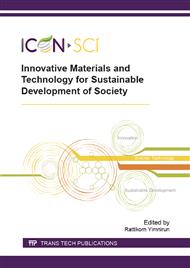[1]
D. D. L. Chung, Cement-Based Electronics, J Electroceram. 6 (2001) 75-88.
Google Scholar
[2]
S. Schwarzer. A. Roosen, Tape casting of piezo ceramic/polymer composites, J. Eur. Cram. Soc. 19 (1999) 1007-1010.
DOI: 10.1016/s0955-2219(98)00363-x
Google Scholar
[3]
S. T. Lau, K.W. Kwok, H.L.W. Chan. C.L. Choy, Piezoelectric composite hydrophone array, Sens. Actuators A. 96 (2000)14-20.
DOI: 10.1016/s0924-4247(01)00757-9
Google Scholar
[4]
Z. Li, D. Zhang, K. Wu, Cement-based 0-3 piezoelectric composites, J. Am. Ceram. Soc. 85 (2002) 305-313.
Google Scholar
[5]
B. Dong, Z. Li, Cement-based piezoelectric ceramic smart composites, Compos. Sci. Technol. 65 (2005) 1363-1371.
DOI: 10.1016/j.compscitech.2004.12.006
Google Scholar
[6]
A. Chaipanich, Dielectric and piezoelectric properties of PZT–cement composites, Curr App Phys. 7 (2007) 537-539.
DOI: 10.1016/j.cap.2006.10.015
Google Scholar
[7]
V. Singh , H.H. Kumar, D.K. Kharat , S. Hait, M.P. Kulkarni, Effect of lanthanum substitution on ferroelectric properties of niobium doped PZT ceramics, Mater. Lett. 60 (2006) 2964-2968.
DOI: 10.1016/j.matlet.2006.02.041
Google Scholar
[8]
D.W. Wang, D.Q. Zhang, J. Yuan , Q.L. Zhao, H.M. Liu , Z.Y. Wang, M.S. Cao, Structural and electrical properties of Nd ion modified lead zirconate titanate nanopowders and ceramics, Chin. Phys. B. 18 (2009) 2596-2602.
DOI: 10.1088/1674-1056/18/6/079
Google Scholar
[9]
N. Duan, N. Cereceda, B. Noheda, J.A. Gonzalo, Dielectric characterization of the phase transitions in Pb 1-y/2(Zr 1-xTi x) 1-yNb yO 3(0. 03≤x≤0. 04, 0. 02≤y≤0. 05), J. Appl. Phys. 82 (1996) 779-784.
Google Scholar
[10]
Z. Ujma, J. Handerek , G.E. Kugel, Phase transitions in Nb-doped Pb(Zr0. 95Ti0. 05)O3 ceramics investigated by dielectric, pyroelectric and Raman scattering measurements, Ferroelectrics. 198 (1997) 77-97.
DOI: 10.1080/00150199708228340
Google Scholar
[11]
D.W. Wang, M.S. Cao, J. Yuan, Q.L. Zhao, H.B. Li, D.Q. Zhang, S. Agathopoulos, Enhanced piezoelectric and ferroelectric properties of Nb2O5 modified lead zirconate titanate-based composites, J Am Ceram Soc. 94 (2011) 647-650.
DOI: 10.1111/j.1551-2916.2010.04309.x
Google Scholar
[12]
E.M.R. Fairbairn, B. B. Americano, G. C. Cordeiro, T. Paula, R. D. T. Filho, M. Silvoso, Cement replacement by sugar cane bagasse ash: CO2 emissions reduction and potential for carbon credits, J. Environ. Manage. 91 (9) (2010) 1864-1871.
DOI: 10.1016/j.jenvman.2010.04.008
Google Scholar
[13]
M. Safiuddin, J. West, K. Soudki, Properties of freshly mixed self-consolidating concretes incorporating rice husk ash as a supplementary cementing material, Con. Buil. Mats. Vol. 30 (2012) 833-842.
DOI: 10.1016/j.conbuildmat.2011.12.066
Google Scholar
[14]
M. F.M. Zain, M. N. Nazrul, M. Jamil, Production of rice husk ash for use in concrete as a supplementary cementitious material, Con. Buil. Mats. 25(2011) 798-805.
DOI: 10.1016/j.conbuildmat.2010.07.003
Google Scholar
[15]
N. Jaitanong, R. Rianyoi, R. Potong, R. Yimnirun, and A. Chaipanich, Effects of PZT content and particle size on ferroelectric hysteresis behavior of 0-3 lead zirconate titanate - Portland cement composites, Int. Ferro. 107 (2009) 43-52.
DOI: 10.1080/10584580903324402
Google Scholar
[16]
N. Jaitanong, H.R. Zeng, G.R. Li, Q.R. Yin, W.C. Vittayakorn , R. Yimnirun , A. Chaipanich, Interfacial morphology and domain configurations in 0-3 PZT-Portland cement composites, Appl. Sur. Sci. 256 (2010) 3245-3248.
DOI: 10.1016/j.apsusc.2009.12.013
Google Scholar
[17]
U. Dabai, C. Muhammad, B.U. Bagudo and A. Musa, Studies on the Effect of Rice Husk Ash as Cement Admixture, J. Basic. Appl Sci. 17 (2009) 252-256.
DOI: 10.4314/njbas.v17i2.49917
Google Scholar


